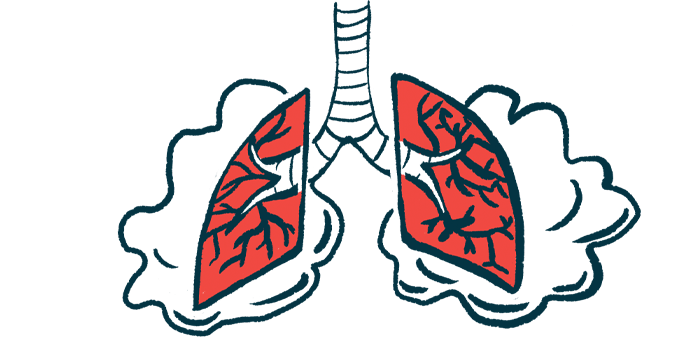Pulmonary hypertension may be scleroderma marker of prognosis
Researchers grouped patients by internal involvement, not skin symptoms
Written by |

The onset of pulmonary hypertension (PH), or high blood pressure in the lungs, may be a critical factor in predicting disease progression and poorer survival in systemic sclerosis (SSc), a study from France suggests.
By grouping patients based on internal organ involvement, rather than relying on traditional classifications based on skin symptoms, the researchers found that the group that included patients who developed PH had significantly lower overall survival rates. The study, “Phenotypes and prognosis of systemic sclerosis: A cluster analysis,” was published in Respiratory Medicine and Research.
SSc, or scleroderma, is an autoimmune disease that causes hardening and scarring of the skin, along with the buildup of scar tissue in internal organs, particularly the lungs, heart, and kidneys, leading to a range of symptoms. Patients have been traditionally classified based on the extent of skin involvement, but this approach often fails to reflect how severely internal organs are affected or to predict how the disease will progress.
Besides lung complications such as PH and interstitial lung disease (ILD) — a group of conditions that cause inflammation and scarring in the lungs — other poor prognostic factors in SSc include being male, kidney or heart involvement, and being older.
Grouping patients by internal organ involvement
Researchers analyzed data from 198 adults with SSc to identify and characterize subgroups based on poor prognostic factors, rather than skin symptoms, and to examine how these subgroups relate to disease outcomes. All the patients were seen at a hospital in Montpellier, France, between 2014 and 2016, and their records were reviewed retrospectively from their diagnosis until April 2018.
The patient population was 84% female. ILD was present in 41.5% of cases, and PH in 14%. Regarding skin involvement, 79% had the limited form of SSc, 18% the diffuse form, and 3% sine scleroderma, where skin involvement is absent or reduced.
Antinuclear antibodies (ANA; against the cell nucleus), self-reactive antibodies found in SSc, were detected in 98% of patients. Among these, 32% had anti-topoisomerase I antibodies (ATA), commonly linked to diffuse skin involvement and more severe lung disease. Another 44% had anti-centromere antibodies (ACA), which are typically associated with limited skin involvement, whereas 2% had anti-RNA polymerase III antibodies that have been linked to diffuse skin involvement and severe internal organ involvement.
The researchers identified four distinct subgroups with different disease patterns and outcomes. The mean age at diagnosis of the four groups ranged from 47 to 51.
In the first group (12.6% of patients), mostly composed of women, all the patients had PH, with half showing severe forms. Most (64%) also had ILD, and 32% had heart disease. Lung function was impaired in this group. ATAs were present in 36% of patients and ACAs in 32%. Almost half (43%) the patients in this group reported occupational exposure, mostly to silica, which is associated with worse outcomes.
The second group (5.6% of patients) included all cases of SSc-related kidney involvement and was predominantly female. ILD and general heart issues were each seen in 36% and three patients had severe PH. Occupational exposure was low, at 12%.
The third group (55.1% of patients) included only women, with 90% having the limited cutaneous form. ACAs were present in 62% and 22% had ILD, though lung function remained largely unaffected. Only 9% had occupational exposure, mainly involving cleaning agents.
The fourth group (26.7% of the population) included an even number of women and men. Although the limited skin form was still most common, this group had the highest proportion of diffuse cutaneous disease (34%). Most (83%) tested positive for ATAs and ILD was found in 79%. About 17% had more severe lung scarring patterns. Occupational exposure, especially to silica dust, was reported in 43% of cases.
Mortality rates in scleroderma
The first group had the highest death rate, although the specific causes of death weren’t recorded. A survival analysis showed two peaks in deaths, one occurring early, likely due to more aggressive forms, and the other later, suggesting some patients developed lung problems as the disease progressed, the researchers said.
This late-phase mortality may be explained, al least in part, by patients from other groups who developed PH over time and shifted into the first group as their disease progressed. This also helps explain the variability of PH types in the first group, which included pulmonary arterial hypertension, patients with PH due to heart disease, and PH due to ILD.
As for the second group, its mortality rate due to kidney damage (9%) was consistent with published studies, the researchers said.
Heart rhythm disorders, previously reported as an early sign of PH developing later, were more common in groups 1 and 2. The third group showed low mortality early on, though deaths appeared after several decades, likely related to a higher cancer rate. Mortality was higher in the early years in the fourth group, with some patients developing PH later in their disease course.
Environmental exposure also appeared to factor in disease severity. Most of the patients exposed to harmful airborne substances were found in groups 1 and 4, also the groups with the most severe lung involvement. Lastly, male patients had a poorer prognosis overall and were more frequently represented in the groups with serious lung complications.
“This study characterized systemic sclerosis [profiles], highlighting the heterogeneity in clinical presentation and disease course,” the researchers wrote. “The trajectory of patients within each cluster was associated with the onset of pulmonary hypertension onset, which adversely affected the prognosis.”






